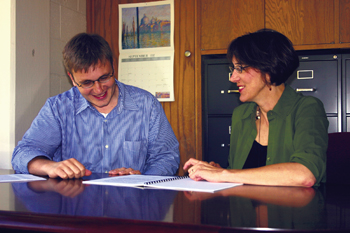
Zachary Warren, Ph.D., and Wendy Stone, Ph.D., discuss the Kennedy Center’s involvement in a new autism research project.
Photo by Melanie May
Kennedy Center joins elite research group
Vanderbilt Kennedy Center's autism research team is joining an elite group of 11 institutions that are combining clinical and genetics expertise for a large-scale study of families with one child with autism in hopes of one day understanding what genes underlie autism.
A three-year, $1 million, grant from the Simons Foundation has VKC well positioned to foster an ideal environment for its team to recruit, evaluate and sample 'simplex' families, meaning that only one child is presenting indicators of being on the autism spectrum.
The Simons Foundation Simplex Family Resource Project is a multi-center enterprise/cooperative that includes Harvard, Yale, Emory, the University of Michigan, McGill University (Montreal), Columbia University (New York), University of Illinois-Chicago, UCLA, University of Washington (Seattle) and Washington University (St. Louis).
VKC will recruit 75-100 families in the first year of the project and 100 families in subsequent years. The group of 11 project sites will collectively recruit 1,000 or more families containing one child with autism, at least one child without autism, and both parents.
“This is an extremely important step in our efforts to advance research in the genetics, molecular biology and cognitive neuroscience of autism and autism spectrum disorders,” said Gerald Fischbach, M.D., scientific director of the Simons Foundation.
“I believe that this group will form a vital and intellectually stimulating core resource.”
James Sutcliffe, Ph.D., is VKC's overall principal investigator for the project and Wendy Stone, Ph.D., is the phenotype principal investigator. Zachary Warren, Ph.D., is overseeing the clinical operation and will be responsible for coordinating all aspects of the study at the Vanderbilt recruitment site.
“Vanderbilt and groups including the Autism Genetic Resource Exchange have collectively recruited large samples of families with two or more children with autism in the past,” Sutcliffe said.
“What has been missing is a similarly large, and clinically well characterized, set of 'simplex' families in which there is only one affected member.”
Sutcliffe said this project is important because it will develop a large resource consisting of a collection of families and related samples (DNA) and clinical/phenotypic data on the affected child and parents and siblings.
“This data and DNA will be put into a repository so qualified scientists and research groups can apply different strategies to study genes and behavior and relationships between the two,” he said.
“By making the data and samples widely available, and letting people try different approaches to discovery, we believe that real progress can be made.
“By bringing the top autism research institutions and their scientists together, the Simons Foundation and the investigators are able to put the best minds to work to make the discoveries we need to understand what causes autism.”













